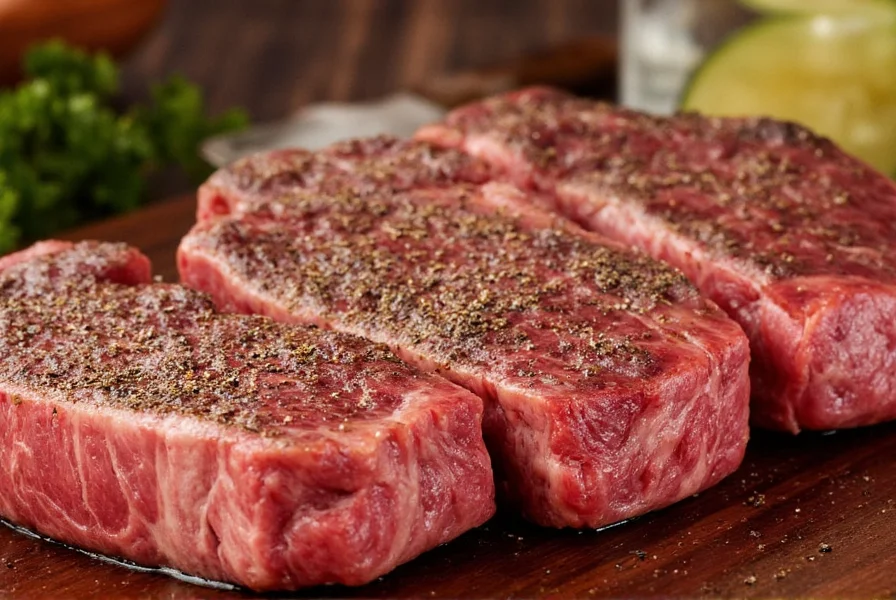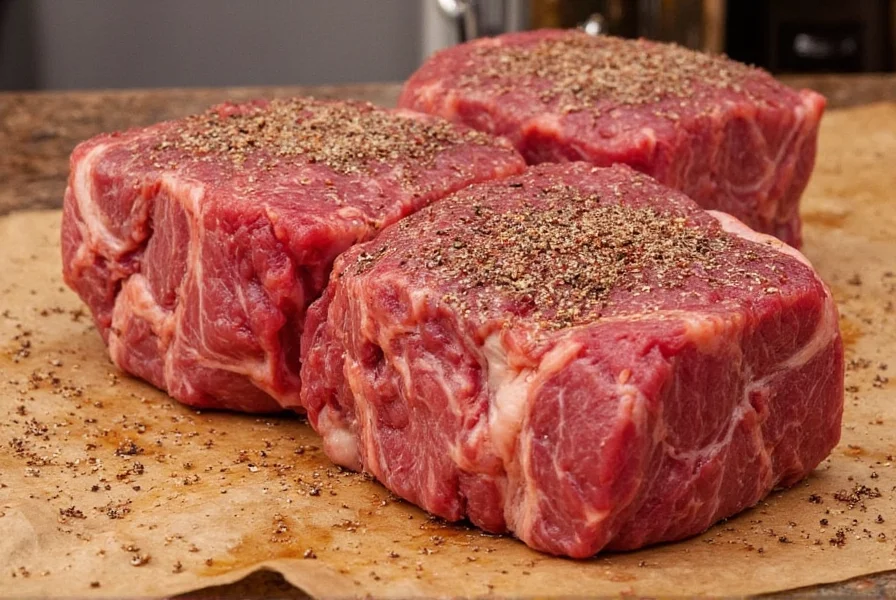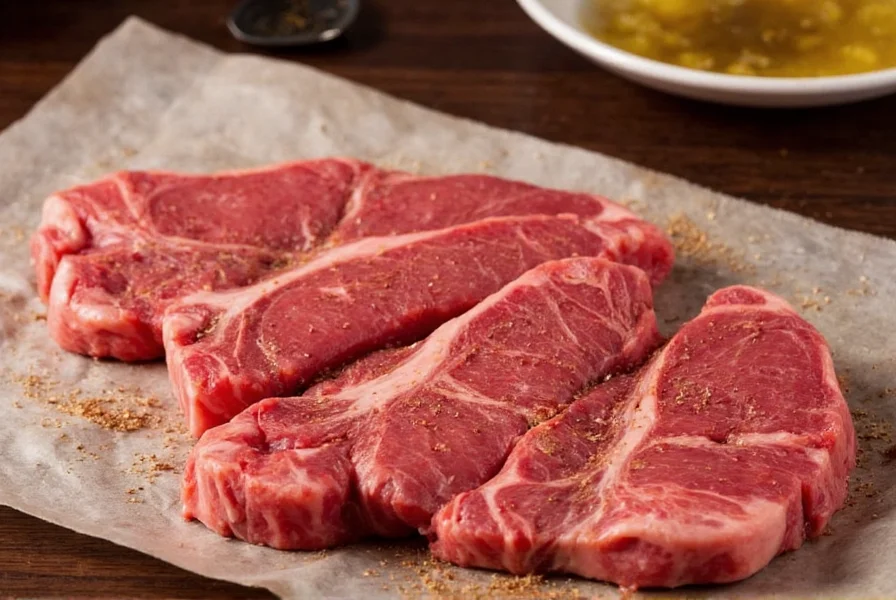The most effective way to season steaks is to generously coat both sides with coarse kosher salt (about 1 teaspoon per pound) and freshly ground black pepper at least 40-60 minutes before cooking, allowing the salt to penetrate the meat. For best results, use a 1:1 ratio of salt to pepper, and consider adding garlic powder or other complementary spices based on your steak cut and cooking method. Never season with salt immediately before cooking as it draws out moisture, and avoid pre-mixed seasoning blends with fillers that burn easily.
Seasoning steak properly transforms an ordinary cut into an extraordinary meal. Many home cooks make critical errors that compromise flavor and texture, from using the wrong salt to timing mistakes that prevent proper crust formation. Understanding the science behind seasoning helps you achieve restaurant-quality results consistently.
Why Proper Steak Seasoning Matters
Seasoning isn't just about flavor—it affects texture, moisture retention, and crust development. Salt breaks down muscle fibers through osmosis, allowing it to penetrate deeper when applied well before cooking. This process enhances tenderness while drawing surface moisture that evaporates during searing, creating that perfect caramelized crust. The right seasoning technique can elevate even modest cuts like flank or skirt steak.
Essential Seasonings for Steak
Keep your steak seasoning simple but strategic. The foundation consists of just two ingredients:
| Seasoning | Recommended Type | Application Ratio |
|---|---|---|
| Salt | Coarse kosher salt (Diamond Crystal) | 1 tsp per pound of steak |
| Pepper | Freshly ground black pepper | 1 tsp per pound of steak |
Why coarse kosher salt? Its larger crystals distribute more evenly and dissolve at the optimal rate. Table salt's fine grains can over-penetrate, creating uneven seasoning. For best way to season ribeye steak, add 1/4 teaspoon garlic powder per pound, which complements the marbling without overpowering.

Timing: When to Season Steak for Optimal Results
The timing of seasoning dramatically impacts your steak's texture:
- 60-90 minutes before cooking: Ideal for thicker cuts (1.5"+). Salt penetrates deeply while surface dries for superior searing
- Immediately after drying: For thinner cuts under 1", season right before cooking to prevent excessive moisture loss
- Never: Season 10-30 minutes before cooking—this creates a salty liquid layer that steams rather than sears
Professional chefs call the 60+ minute window the "dry brine" method. During this time, salt dissolves in surface moisture, then gets reabsorbed into the meat, seasoning from within while drying the exterior for perfect crust formation.
Step-by-Step Steak Seasoning Process
Follow this precise method for consistently excellent results:
- Pat steak completely dry with paper towels—moisture is the enemy of proper seasoning adhesion
- Apply coarse kosher salt evenly to all surfaces (including edges) using a 1:1 ratio by volume
- Place seasoned steak on a wire rack over a tray in the refrigerator, uncovered
- Wait 60-90 minutes for thicker cuts, 15-20 minutes for thinner cuts
- Pat dry again immediately before cooking to remove any surface moisture
- Apply freshly ground black pepper and any additional spices just before cooking
This process addresses the common question of when to salt steak before grilling—always well in advance for optimal results. The refrigerator's dry environment accelerates surface drying while the salt works its magic internally.
Special Considerations for Different Cuts
Not all steaks season the same. Adjust your approach based on cut characteristics:
- Ribeye: Use slightly less salt (3/4 tsp/lb) due to higher fat content; add garlic powder for complementary flavor
- Filet mignon: Increase pepper ratio (1.5:1 pepper to salt) to complement mild flavor
- Flank/skirt: Include 1/2 tsp cumin per pound for these more robust cuts
- Wagyu/Kobe: Season minimally—just salt—to appreciate the inherent marbling flavors
Understanding proper steak seasoning ratio for specific cuts prevents overpowering delicate flavors while enhancing bolder ones. For dry-aged steaks, reduce salt by 25% since the aging process concentrates flavors.

Common Steak Seasoning Mistakes to Avoid
Even experienced cooks make these critical errors:
- Using iodized table salt: Creates bitter, uneven seasoning; stick with kosher or sea salt
- Seasoning too late: Applying salt just before cooking prevents proper penetration
- Adding sugar too early: Burns easily—only add during last minute of cooking
- Overcomplicating: More than 3-4 seasonings typically overwhelms beef's natural flavor
- Seasoning frozen steak: Moisture prevents proper adhesion—always thaw completely first
Many home cooks ask should I put olive oil on steak before seasoning? The answer is no—oil creates a barrier that prevents salt from properly adhering to the meat surface. Apply oil directly to your cooking surface instead.
Advanced Seasoning Techniques
For those ready to elevate their steak game:
- Compound butter finish: After cooking, top with herb butter containing complementary seasonings
- Post-sear seasoning: For delicate spices like smoked paprika, apply during last minute of cooking
- Dual-salt approach: Use 75% kosher salt for penetration and 25% flaky sea salt for finishing texture
- Acid balance: A light citrus or vinegar-based spray after cooking brightens heavy seasonings
Remember that how long to let steak sit after seasoning depends on thickness—thicker cuts need more time for salt penetration without excessive moisture loss. This timing knowledge separates good steaks from exceptional ones.
Frequently Asked Questions
Can I use sea salt instead of kosher salt for steak?
Yes, but adjust quantities—sea salt crystals are denser than kosher salt. Use about 3/4 teaspoon sea salt per pound instead of 1 teaspoon kosher salt. For best results with sea salt, choose a coarse variety and apply it at least 90 minutes before cooking to allow proper dissolution and penetration.
Should I rinse steak after dry brining?
No, never rinse after dry brining. The purpose of the 60-90 minute rest period is for the salt to dissolve in the meat's surface moisture and then be reabsorbed. Rinsing removes this seasoned layer and reintroduces surface moisture that prevents proper searing. Instead, pat the steak dry one final time immediately before cooking.
Does the type of pepper matter for steak seasoning?
Absolutely. Freshly ground Tellicherry or Madagascar black pepper provides superior flavor and aroma compared to pre-ground varieties. The volatile compounds that give pepper its complexity dissipate quickly after grinding. For optimal results, grind pepper directly onto the steak just before cooking to preserve these delicate flavor compounds that would burn if added too early.
How much seasoning should I use for a 16oz ribeye?
For a standard 16oz (1 pound) ribeye, use exactly 1 teaspoon coarse kosher salt and 1 teaspoon freshly ground black pepper. Ribeyes benefit from slightly less salt (3/4 teaspoon) due to their high fat content, but the full amount works well if you prefer bolder seasoning. Apply evenly to all surfaces, including the fatty edge, which should be scored and seasoned to render properly during cooking.
Can I add seasoning during cooking?
Yes, but strategically. Salt should always be applied well before cooking for proper penetration. However, delicate spices like smoked paprika, cayenne, or dried herbs burn easily and should be added during the last 1-2 minutes of cooking. For reverse-seared steaks, you can apply additional seasoning during the oven phase, but remember that prolonged high heat degrades most spice compounds, so finish with fresh seasoning just before serving for maximum flavor impact.











 浙公网安备
33010002000092号
浙公网安备
33010002000092号 浙B2-20120091-4
浙B2-20120091-4